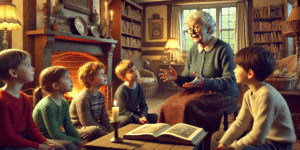Old wives’ tales are traditional beliefs or superstitions passed down through generations, often without scientific basis. These tales cover a wide range of topics, from health and medicine to daily life and superstitions. Their origins can be traced back to ancient times when knowledge was primarily shared orally within communities.
The term “old wives’ tales” itself suggests wisdom from elderly women, who were often the keepers of household and health-related knowledge. Despite being labeled as mere superstition, some old wives’ tales have roots in real experiences and observations, though many have been debunked by modern science. Exploring the origins of these tales reveals insights into cultural beliefs, historical contexts, and the ways in which people have tried to make sense of the world around them. Understanding these origins helps us appreciate how folklore influences contemporary thinking and practices.
Read also: The Artistry of Facial Expressions: Mastering the Craft in Photoshoots
Definition and Characteristics
Old wives’ tales are a form of folklore that reflects the cultural and historical context of the communities in which they originate.
Definition
Old wives’ tales are widely held but often unverified beliefs that are generally passed from older women to younger generations. These tales cover a broad range of topics, including health, weather, pregnancy, and everyday life. They are not based on scientific research but rather on observations and experiences over time.
Characteristics of Old Wives’ Tales
- Oral Tradition: Old wives’ tales are primarily transmitted orally. They are shared through conversations, stories, and word of mouth rather than written texts. This oral tradition helps preserve the tales across generations but can also lead to variations and embellishments over time.
- Anecdotal Evidence: These tales rely on personal experiences and observations rather than scientific data. They often stem from attempts to explain complex or mysterious phenomena in simple, understandable terms.
- Cultural Significance: Old wives’ tales reflect the values, beliefs, and practices of the culture from which they originate. They provide insights into historical ways of thinking and living, offering a glimpse into the past.
- Superstitions and Myths: Many old wives’ tales are rooted in superstitions or myths. For example, the belief that breaking a mirror brings seven years of bad luck or that eating carrots improves vision are common examples. These tales often contain elements of fear or caution.
- Health and Remedies: A significant number of old wives’ tales pertain to health and home remedies. They offer advice on curing ailments or preventing illness, such as drinking chicken soup to recover from a cold or using honey to soothe a sore throat.
- Simplistic Explanations: Old wives’ tales provide straightforward explanations for events or conditions that may not have been well understood in the past. For instance, predicting the gender of an unborn baby based on the shape of the mother’s belly is a common old wives’ tale.
- Persistence and Adaptability: Despite advances in science and technology, old wives’ tales persist and adapt to modern contexts. People continue to share and sometimes believe these tales, finding comfort in their familiarity and the wisdom of previous generations.
Old wives’ tales, while often lacking scientific basis, remain a fascinating aspect of cultural heritage, illustrating the enduring human need to make sense of the world through stories and shared knowledge.
Historical Origins of Old Wives’ Tales
Old wives’ tales have a rich history that dates back to ancient times, reflecting the wisdom and beliefs of various cultures throughout the ages. These tales originated from a combination of early sources and documentation, cultural and regional influences, and have evolved significantly over time.
Early Sources and Documentation
The origins of old wives’ tales can be traced back to ancient civilizations, where knowledge and advice were primarily transmitted orally. In societies with limited scientific understanding and literacy, people relied on storytelling to pass down practical knowledge and superstitions. Early sources include ancient texts and folklore. For example, some old wives’ tales can be found in ancient Greek and Roman literature, where they were documented as part of medical and natural history writings. These tales often incorporated elements of myth and legend, blending practical advice with fantastical explanations.
Cultural and Regional Origins
Old wives’ tales are deeply rooted in the cultural and regional contexts from which they emerge. Different societies developed their own unique sets of beliefs and superstitions based on their environment, lifestyle, and experiences. For instance, in agrarian societies, many old wives’ tales are related to farming practices, weather predictions, and animal behavior. In contrast, maritime cultures have tales connected to the sea, navigation, and fishing. These cultural and regional origins explain why some old wives’ tales are specific to certain areas and why similar tales might have different versions across various cultures. For example, the belief that a black cat crossing your path brings bad luck is common in Western cultures, while in some other cultures, black cats are considered symbols of good fortune.
Evolution Through Time
As societies evolved and scientific knowledge expanded, old wives’ tales also adapted and transformed. The printing press and increased literacy rates played significant roles in the preservation and dissemination of these tales. Books on folklore and traditional remedies began to appear, documenting old wives’ tales for future generations. Despite scientific advancements, many old wives’ tales have persisted, often because they provide simple explanations for complex phenomena or because they are ingrained in cultural traditions. In modern times, these tales continue to evolve, blending with contemporary beliefs and occasionally being validated or debunked by scientific research. For example, the old wives’ tale that eating carrots improves vision has some basis in truth, as carrots are rich in vitamin A, which is essential for eye health.
The historical origins of old wives’ tales reveal a fascinating interplay between tradition, culture, and evolving knowledge. These tales, while often not scientifically accurate, offer valuable insights into the ways our ancestors understood and interacted with the world around them.
Common Examples of Old Wives’ Tales
Old wives’ tales encompass a wide range of topics, from health and medicine to household remedies and superstitions. Here are some common examples:
Health and Medicine
- “An apple a day keeps the doctor away”: This popular saying suggests that eating apples can prevent illness and maintain good health. While it’s not a cure-all, apples are rich in vitamins and fiber, contributing to overall well-being.
- “Feed a cold, starve a fever”: This old adage advises eating well when you have a cold and eating less when you have a fever. Modern medicine, however, recommends maintaining good nutrition and hydration for both conditions.
Pregnancy and Childbirth
- Gender prediction myths: Many old wives’ tales attempt to predict a baby’s gender based on various signs. For example, if a pregnant woman carries her baby high, it’s said to be a girl; if low, a boy. Scientifically, only medical tests like ultrasounds can accurately determine gender.
- Heartburn means a hairy baby: Another common belief is that experiencing heartburn during pregnancy indicates the baby will have a lot of hair. Some studies suggest a possible link, but it’s not a reliable predictor.
Household Remedies
- Vinegar for cleaning: Vinegar is often touted as a natural cleaning agent. It can effectively clean and disinfect surfaces due to its acidic properties. This old wives’ tale has some basis in fact and is widely used in modern eco-friendly cleaning.
- Honey for a sore throat: A common remedy involves using honey to soothe a sore throat. Honey’s antibacterial properties can provide relief and is a scientifically supported remedy.
Superstitions
- Breaking a mirror brings seven years of bad luck: This superstition dates back to ancient times when mirrors were believed to hold a part of one’s soul. Breaking a mirror was thought to damage the soul, leading to bad luck. While this belief persists, there’s no scientific basis for it.
- Knocking on wood: Many people knock on wood to ward off bad luck after saying something hopeful or positive. This practice is believed to originate from ancient pagan rituals involving trees, which were thought to house protective spirits.
- Walking under a ladder: Another common superstition warns against walking under a ladder, as it supposedly brings bad luck. This belief might stem from practical safety concerns, as well as symbolic meanings related to the ladder’s triangular shape, which was considered sacred.
Old wives’ tales, though often lacking scientific evidence, reflect the wisdom and beliefs passed down through generations. They provide a fascinating glimpse into how people historically tried to understand and navigate the world around them.

Scientific Basis of Old Wives’ Tales
Old wives’ tales are a mix of myths and facts, with some having scientific backing while others have been debunked over time. Understanding the scientific basis of these tales helps distinguish between mere superstition and practical wisdom.
Myths vs. Facts
Old wives’ tales often stem from observations and experiences. While some are purely mythical, others have elements of truth that science can explain. For instance, the tale that carrots improve vision is partly true. Carrots are rich in beta-carotene, which the body converts into vitamin A, essential for eye health. However, eating large quantities won’t give you superhuman vision.
Examples with Scientific Backing
- “Chicken soup for a cold”: This common remedy has some scientific support. Studies suggest that chicken soup can help reduce inflammation and congestion, providing relief from cold symptoms. The warm broth helps keep you hydrated and soothes a sore throat, making it a practical, comforting remedy during illness.
- “Honey for a sore throat”: Honey is a popular home remedy for sore throats and coughs. Scientific research supports its use due to its antibacterial and anti-inflammatory properties. Honey can coat the throat and provide temporary relief, and its natural sugars can help suppress coughs.
- “An apple a day keeps the doctor away”: While apples are not a cure-all, they are indeed beneficial for health. Apples are high in fiber, vitamins, and antioxidants, which can support overall health, aid digestion, and help reduce the risk of certain diseases. Regularly eating apples can contribute to a healthy diet.
Debunked Tales
- “Feed a cold, starve a fever”: This old adage has been debunked by modern medicine. Proper nutrition and hydration are crucial for recovery from both colds and fevers. Starving yourself can weaken the immune system, making it harder for the body to fight off infections.
- “Cracking knuckles causes arthritis”: Many people believe that cracking your knuckles can lead to arthritis. However, scientific studies have shown no direct link between knuckle cracking and arthritis. The sound is caused by the release of gas bubbles in the joint fluid, not by damage to the joints.
- “Pregnancy heartburn means a hairy baby”: This tale suggests that experiencing heartburn during pregnancy indicates that the baby will have a lot of hair. While one study found a slight correlation, it is not a reliable predictor. Heartburn is more commonly caused by hormonal changes and physical pressure from the growing baby.
Old wives’ tales provide a mix of wisdom and superstition. While some have been validated by scientific research, others have been debunked, highlighting the importance of distinguishing between myth and fact. Understanding the scientific basis behind these tales can help us appreciate their origins and apply practical advice where appropriate.
Transmission Through Generations
Old wives’ tales have been passed down through generations using various methods that reflect the evolving ways humans share knowledge. These methods include oral tradition, the role of family and community, and written records and literature.
Oral Tradition
The primary way old wives’ tales have been transmitted is through oral tradition. In ancient times, when literacy rates were low, people relied heavily on spoken word to convey information. Elders, particularly women, would share stories, advice, and superstitions with younger family members and community members. This method of storytelling allowed these tales to be easily remembered and repeated. Oral tradition is highly effective in preserving cultural knowledge, as it relies on repetition and social interactions, making it a natural way to pass down wisdom.
Role of Family and Community
Family and community play a crucial role in the transmission of old wives’ tales. Within families, grandparents and parents often share these tales with children as part of their upbringing. These stories are told during everyday activities, such as cooking, cleaning, or before bedtime, embedding them in the daily lives of younger generations. Communities also serve as a significant conduit for these tales. In communal gatherings, festivals, and local events, individuals share their experiences and beliefs, reinforcing the tales within the collective memory of the group. This communal sharing helps maintain the relevance and continuity of old wives’ tales.
Written Records and Literature
As societies advanced and literacy became more widespread, old wives’ tales began to be documented in written form. Early records can be found in ancient texts, manuscripts, and later in printed books. These written records helped preserve the tales more accurately and allowed them to reach a broader audience. Literature, including folklore collections, children’s books, and cultural anthologies, has played a significant role in keeping these tales alive. Authors and scholars have collected and published old wives’ tales, ensuring their survival even as oral traditions wane.
Modern technology has further extended the reach of old wives’ tales. With the advent of the internet, social media, and digital archives, these tales are now shared globally, reaching audiences far beyond their original cultural contexts. This digital transmission allows for both the preservation of traditional versions and the creation of new interpretations.
Old wives’ tales have been passed down through generations primarily through oral tradition, supported by the pivotal roles of family and community. The advent of written records and literature has further ensured their preservation and dissemination. These methods together have allowed old wives’ tales to remain a vibrant part of cultural heritage, continuously evolving while maintaining their core wisdom.
Harmful vs. Beneficial Tales
Old wives’ tales are traditional beliefs passed down through generations, and they can be either harmful or beneficial. Understanding their potential dangers and benefits helps us make informed decisions about following them.
Potential Dangers of Following Old Wives’ Tales
Some old wives’ tales can be harmful, especially when they involve health and medical advice without scientific backing. For instance:
- Medical Misguidance: Following outdated or incorrect health advice can delay proper medical treatment. For example, the old belief that placing butter on burns can help heal them is actually harmful. Butter can trap heat in the skin and increase the risk of infection. Modern medicine recommends using cool water to treat burns instead.
- Superstitions Leading to Anxiety: Some old wives’ tales are rooted in superstition and can cause unnecessary fear and anxiety. Believing that breaking a mirror will bring seven years of bad luck or that walking under a ladder is dangerous can create undue stress. These superstitions have no scientific basis and can lead to irrational behavior.
- Dangerous Home Remedies: Certain home remedies suggested by old wives’ tales can be unsafe. For instance, using kerosene to kill head lice, as some old tales suggest, is extremely hazardous due to its flammability and toxicity. Safe and effective treatments are available and should be used instead.
Beneficial Practices That Originated from Old Wives’ Tales
Not all old wives’ tales are harmful; some have beneficial aspects that modern science has validated. For example:
- Nutritional Advice: The saying “An apple a day keeps the doctor away” encourages healthy eating habits. Apples are nutritious, containing vitamins, fiber, and antioxidants that contribute to overall health. Encouraging regular consumption of fruits and vegetables aligns with modern dietary recommendations.
- Natural Remedies: Some old wives’ tales promote natural remedies that have been found beneficial. Honey, for instance, has been used for centuries to soothe sore throats and coughs. Modern research supports its antibacterial and anti-inflammatory properties, making it a valid home remedy.
- Practical Household Tips: Many old wives’ tales offer practical advice for everyday tasks. Using vinegar for cleaning is one such example. Vinegar is an effective and natural cleaning agent that can disinfect surfaces and remove odors. This environmentally friendly practice has been embraced in modern households.
Old wives’ tales can be both harmful and beneficial. It’s essential to approach them with a critical mindset, distinguishing between outdated superstitions and practical wisdom supported by scientific evidence. By doing so, we can avoid potential dangers while embracing helpful practices that contribute to our well-being.
Academic Study of Old Wives’ Tales
Historians and folklorists play a crucial role in studying old wives’ tales, helping to preserve cultural heritage and understand the beliefs and practices of past societies. Their work involves various methods of research and analysis, contributing valuable insights into these traditional narratives.
Role of Historians and Folklorists
Historians and folklorists are dedicated to studying the past and understanding the cultural significance of stories, myths, and traditions. In the context of old wives’ tales, they examine how these tales have shaped and reflected societal values, behaviors, and knowledge. Historians often focus on the historical context and evolution of these tales, while folklorists analyze their cultural meanings, variations, and functions within communities.
Methods of Studying Old Wives’ Tales
- Oral History and Interviews: One primary method is collecting oral histories and conducting interviews with individuals who remember and share these tales. This approach helps capture the original context and variations of the tales as told by different generations. It also allows researchers to document the living tradition of storytelling.
- Textual Analysis: Researchers study written records, manuscripts, and literary works that contain old wives’ tales. By analyzing these texts, historians and folklorists can trace the origins, changes, and dissemination of these tales over time. This method provides a historical timeline and reveals how tales have adapted to different cultural contexts.
- Ethnographic Fieldwork: Folklorists often engage in ethnographic fieldwork, immersing themselves in communities to observe and document how old wives’ tales are shared and maintained in daily life. This method provides a deeper understanding of the social functions and meanings of these tales within specific cultural settings.
- Comparative Analysis: By comparing old wives’ tales from different cultures and regions, researchers can identify common themes and variations. This comparative approach helps to understand the universal aspects of human experience and the unique cultural expressions found in different societies.
Notable Researchers and Their Contributions
Several researchers have made significant contributions to the study of old wives’ tales:
- Sir James George Frazer: A pioneering anthropologist, Frazer’s work “The Golden Bough” explored myths, magic, and folklore, providing a foundation for understanding the cultural and psychological functions of traditional narratives.
- Richard Dorson: Known as the “father of American folklore,” Dorson conducted extensive fieldwork and research on American folk traditions, including old wives’ tales. His work helped establish folklore as an academic discipline.
- Maria Tatar: A prominent folklorist, Tatar has written extensively on fairy tales and folklore, examining their psychological and cultural significance. Her research sheds light on the enduring power and relevance of traditional stories in contemporary society.
Historians and folklorists use various methods to study old wives’ tales, revealing their historical evolution and cultural meanings. Their work preserves these traditional narratives and enhances our understanding of the human experience across different times and places.
Read also: Moving Abroad to Pursue a Nomadic Lifestyle
Modern Relevance of Old Wives’ Tales
Old wives’ tales continue to hold a place in popular culture and have adapted to contemporary society in various ways. Their persistence and modern interpretations demonstrate how these traditional stories remain relevant today.
Persistence in Popular Culture
Old wives’ tales are deeply ingrained in popular culture. They are often shared in conversations, referenced in media, and used in advertising. For example, the tale that carrots improve vision is frequently mentioned in health discussions and marketing for nutritional products. These tales provide simple explanations and advice that resonate with people’s everyday experiences, making them easy to remember and share. Their continued presence in popular culture underscores their enduring appeal and the comfort they provide as familiar, time-tested wisdom.
Adaptation to Contemporary Society
Many old wives’ tales have adapted to fit the context of modern life. With advances in science and technology, some tales have been validated, while others have been debunked. However, the essence of these tales often remains, albeit in updated forms. For example, the old belief in the health benefits of garlic has found support in modern research highlighting garlic’s antimicrobial properties. Similarly, traditional advice on the importance of staying hydrated during illness has been reinforced by contemporary medical guidelines. Additionally, the internet and social media have facilitated the spread and adaptation of old wives’ tales, allowing them to reach new audiences and evolve with current trends and knowledge.
Examples of Modern Interpretations
- Health and Wellness: Many old wives’ tales related to health have been reinterpreted with scientific backing. The tale that honey can soothe a sore throat is now widely accepted and recommended by healthcare professionals. This modern acceptance of traditional remedies shows how old wisdom can align with contemporary medical practices.
- Parenting Advice: Old wives’ tales about pregnancy and childcare continue to influence modern parenting. For example, the advice that ginger can alleviate morning sickness is now supported by scientific studies. Modern parents often turn to these traditional remedies, finding comfort in their long history of use.
- Environmental Practices: Old wives’ tales about household cleaning have seen a resurgence with the growing interest in eco-friendly practices. The use of vinegar and baking soda for cleaning, once considered old-fashioned, is now popular in green living circles. This shift reflects a return to simpler, more natural solutions in response to concerns about chemical cleaners.
Old wives’ tales persist in modern culture, adapting to contemporary society while maintaining their core messages. Their presence in popular culture, validation by scientific research, and modern reinterpretations highlight their enduring relevance. These tales continue to offer valuable insights and practical advice, bridging the gap between traditional wisdom and modern knowledge. Their evolution and persistence demonstrate the timeless nature of human storytelling and the ongoing search for understanding and meaning in everyday life.








